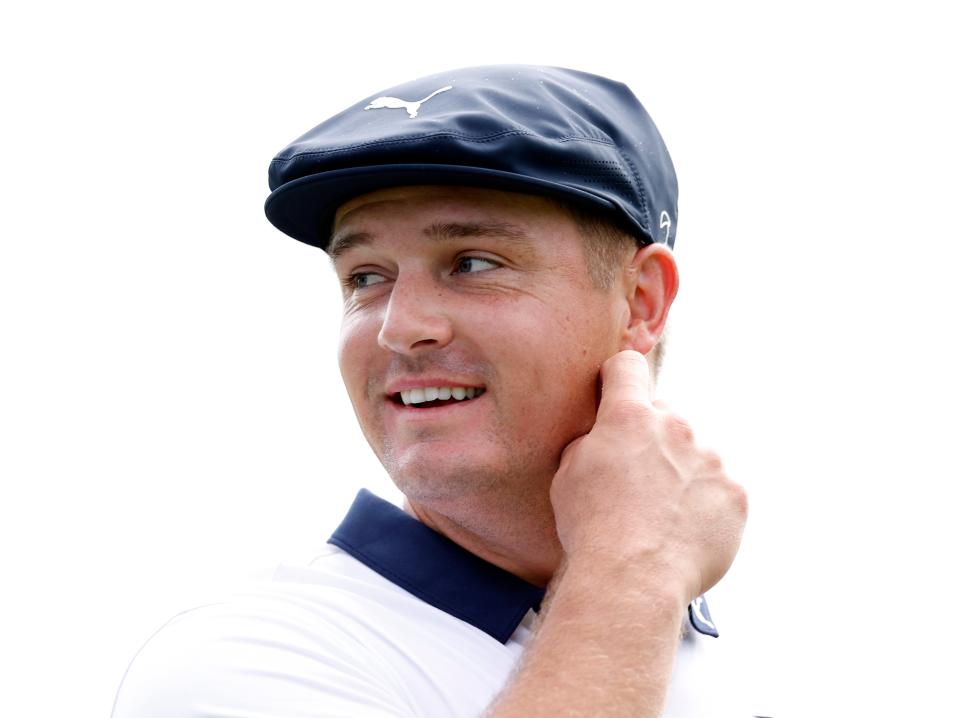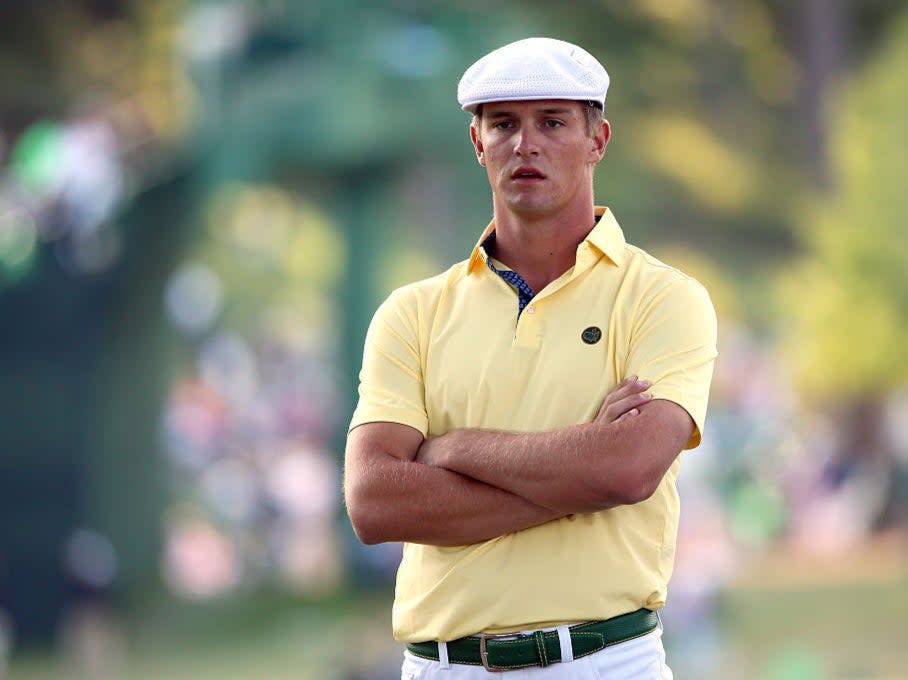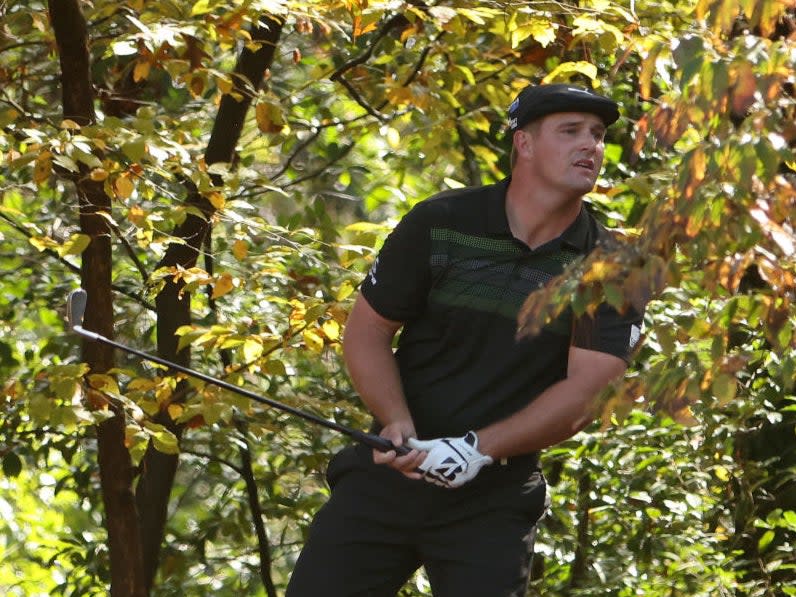Inside the mind of Bryson DeChambeau, golf’s polarising genius

Bryson DeChambeau heads to Augusta as one of the favourites
(Getty Images)Three years ago, on the range at Carnoustie, Bryson DeChambeau was having what can only be described as an existential breakdown. After a dismal first round at the 2018 Open, golf’s tortured genius tossed his clubs down the fairway, fell to his haunches, and gazed out over the edge of the earth. The curse of the perfectionist, as he knew all too well, is that no matter how far you search, you can never find all the answers.
“The one thing I always told Bryson is if you’re going down a rabbit hole, you have to be willing to fail,” says Mike Schy, DeChambeau’s first coach. “That was always difficult for Bryson, and it still is till this day.”
But the legacy of that implosion ultimately led DeChambeau out of that mire and into the light. No longer threatening his own wellbeing, instead, he has embarked on a path that’s manhandling golf into a brute strength revolution - or, in some people’s eyes, towards a breaking point. After adding 20kg to his already sizeable frame last year, he has won three events, including a lap of the field at the US Open, and risen to No 5 in the world rankings.
More significant, though, has been the ripple effect. Rory McIlroy has wrecked his own swing in an effort to match DeChambeau’s distance. Meanwhile, the USGA are accelerating plans to more strictly regulate equipment and local rules are being implemented to prevent DeChambeau simply cutting large corners of the sport’s most garlanded courses. Rarely has a player ever had such a polarising allure, but for all the questions he has asked of himself, there remains only one that again trails the American heading into The Masters this week: Can Bryson DeChambeau dismantle Augusta?
****
“People think Bryson’s the mad scientist,” says Schy, with a booming laugh building in the back of his throat. “Then, when they realise who I am, they think he’s just the Frankenstein who got off the table.”
There can be no doubting DeChambeau’s preternatural inquisitiveness, but it was under a sprawling tent at Dragonfly Golf Club, surrounded by farmland in rural California, that the seeds of his obsession and maddening idiosyncrasies were sewn. Schy, an unapologetically dry but endearing instructor, likens it to a “science experiment gone wrong”, with misshapen golf clubs heaped in corners like a metal workshop. To lead a revolution, first, you have to start one, and when DeChambeau first walked into Schy’s Performance Institute as an 11-year-old, the years of painstaking trial and error, tears and frustration began.
Schy is a devout ideologue of The Golfing Machine, an instructional manual, first published in 1969, that reads like an arcane physics dissertation and systematically reduces the swing to excruciatingly detailed, robotised mechanics. It has long held a controversial reputation, often eschewed as overly eccentric and plainly unartistic. To Schy, that was always a false contradiction and, in DeChambeau, he had a fascinated and utterly determined subject.
Read more
“I’m dyslexic so reading that book wasn’t the easiest thing for me,” Schy says with another chuckle. “But Bryson loved geometry, I threw it at him aged 15, when he could really understand it, and he started going ‘this is awesome, why haven’t you been teaching me this from the beginning?’” Only after he finished reading did DeChambeau realise Schy had been ingraining him with the book’s fundamentals for the past four years.
Soon afterwards, DeChambeau was beginning to question some of golf’s most basic traditions and, in typical fashion, his melting pot of ideas began to spill over in a moment of frustration on the range. “We were at the US Amateur Championship and he asks me why we have to play different length clubs,” says Schy. “I said, well we don’t but it’s a very difficult question to answer. Anything you do could be great, but there are obstacles to being outside of the norm. People will criticise your appearance, coaches will say you’re crazy, that it doesn’t work, that it’s not ‘traditional’. You have to be prepared to go through that and it’s not easy. Many guys have tried it, but their psyches can’t deal with the conflict and they bail.”

Never one to be deterred, straight after the tournament, DeChambeau and Schy set to work. “First of all, we didn’t have any money at that point, so I found a set of old Nike clubs and said ‘okay, let’s go ahead and destroy these’.” Together in Schy’s tent, they ground every clubhead down to 280g, balancing them with lead tape, until each iron was exactly the same length. “We had lots of obstacles right off the get-go. At first, Bryson’s dad hated it and every time Bryson would go home, his dad would call me saying ‘you’re wrecking my kid’. There were a lot of after round crying sessions and emotional outbursts as a kid. I’d have to remind Bryson that it’s only one day, he’s in test mode and we can now check off whether something does or doesn’t work. That’s been our journey all along.”
By the time DeChambeau was studying physics at Southern Methodist University (SMU) in Texas, fanning his obsession with biomechanics while positing theories on proton decay, he and Schy had moved out of the development stage. He became one of the most successful amateurs in golf’s history, winning the US Amateur and NCAA Championship with a one-plane swing. He had completed the first of his radical transformations, and yet its success had only heightened his curiosity. Now the question was rather more simple: what’s next?
****
DeChambeau first visited Greg Roskopf’s Muscle Activation studio in Denver after he left SMU. Traditionally, Roskopf had always worked with NFL and NBA players, restoring their bodies after the inevitable deterioration caused by high-impact training. But before even joining the PGA Tour, DeChambeau’s bludgeoning swing was beginning to take its toll, with a lingering pain in his lower back and hip.
“When Bryson first came to see me, it was just to get his body balanced,” says Roskopf. “We spent a year and a half taking the stress off and increasing his range of motion, joint by joint, movement by movement. That was the main plan but then Bryson got intrigued by the system, so we said let’s challenge this and take it up a notch.”
In a sense, Roskopf’s system is like a Golf Machine for the body, isolating 43 individual movements, and strengthening each in remarkably exact detail. On a trunk rotation exercise, for example, DeChambeau increased the power of his lift by 40lbs in the space of one afternoon. He was immediately enraptured by the improvement, spending hours talking with Roskopf about the programme down to the most infinitesimal details.
His transition to the PGA Tour over that period, however, had not been as smooth as expected. In his first two years, DeChambeau missed upwards of 20 cuts, his swing volatile and inconsistent, even after winning his maiden event at the John Deere Classic in 2017.
“[When he first got on the PGA Tour] the problem was the pressures from a mental standpoint,” says Schy. “He missed a lot of cuts and there were many days, especially after cut No 15 or whatever, when he’d be like I don’t want to do this anymore. He’d be feeling that dejected. He wouldn’t sign autographs because he’d feel like he’d let people down.”
It wasn’t so much off the tee but on the greens where DeChambeau was unravelling. He began to trial several different putting methods, even briefly attempting a side-saddle, before settling on the stiff, lock-armed technique that he now uses so effectively. “He’s worked his butt off to become a very good putter,” says Schy.
In the space of four months in 2018, beginning just weeks after his meltdown at The Open, everything started to click. DeChambeau began working with Chris Como, another biomechanics disciple who previously worked as a swing coach to Tiger Woods and won three high-profile events. With that steady foundation back in place, DeChambeau’s next transformation started to gather pace. “Distance was always the low-hanging fruit,” says Schy. “He’s always been intrigued by hitting it far.”

As Roskopf managed the stress on his body, DeChambeau packed on the weight via a cocktail of high-calorie meals and protein shakes. “We saw exponential changes in strength that you don’t see in literature or the real world,” Roskopf says. “Over the last year and a half, in every single one of the movements we’ve gone through in his body, he’s doubled in strength. I’ve been in pro sports for almost 30 years now and I’ve never seen these types of changes.”
Now, it is Como’s Living Room Lab in Frisco, Texas where Frankenstein is being engineered. DeChambeau will spend hours hitting clubs as fast as he possibly can in the coach’s custom-built training paradise, sometimes expending so much energy he feels faint, before poring over every shot in exhausting detail. His swing has been altered dramatically to accustom his swing speed, now capable of exceeding a punishing 215mph with a driver. In fact, Schy says, DeChambeau is swinging his irons so fast the metals are starting to prematurely fatigue.
“He’s realised over the last weeks that the equipment just doesn’t work at these high speeds,” says Schy. “I told him at least now you know where the tolerances are so do your research to try and find a solution. So that’s where he’s at right now, potentially hooking up with a metals guy to understand how [the clubs] work. That doesn’t breed stress for him. It’s just a physics equation. It makes him feel good.”
Only yesterday it was confirmed that DeChambeau will test a new driver at The Masters, with modifications on the toe side to increase consistency at high speeds. “Whether it helps me win the tournament or not, it’s still a massive improvement,” he told Golf.com. “It’s been an all-hands-on-deck at Cobra and they worked super hard to get this ready for Augusta.”
Far from content, though, DeChambeau has also been gleaning knowledge from Kyle Berkshire, the world long driving champion. “He was frustrated because he thought ‘this guy isn’t as strong as I am’,” says Roskopf. “He brought me a video side-by-side where I can compare their swings. Berkshire’s knee was pointing 45 degrees backwards whereas Bryson’s was pointing forwards. So that day we focused on the function of the muscles in his lower leg and feet. After we’d worked through all the ranges, his body rotation had increased by 20 degrees.”
“In December, I asked him if there’s an end game [when he’ll be satisfied with his distance],” says Schy.
“I don’t see it,” DeChambeau replied.
****
For all the furore around DeChambeau pillaging golf’s great courses, Augusta showed him few mercies last November. He entered the week at the eye of a self-inflicted storm, denouncing the course as a par-67, with brash plans to bomb-and-gouge its soft conditions. Instead, after a disappointing opening round, DeChambeau had begun feeling “dull” and “odd” and “numb.” On Friday, he was left flailing to make the cut line after a moment of misfortune on the third, when his ball plugged in the rough and failed to rear its head inside the allotted three minutes.
The fears that DeChambeau would reduce Augusta to a pitch-and-putt were decidedly unfounded. In the words of its greatest exponent, six-time winner Jack Nicklaus, it is “the quintessence of a second-shot golf course.” Unlike Dustin Johnson, whose record-breaking score was built on immaculate wedge play, DeChambeau’s approaches were found wanting, no matter how short the gap into the green.
“The fact he’s making bogeys and missing greens from short distances is because his acceleration has changed,” says Schy. “I’ve asked him if he’s going to work on that, and I’ve told him, be thankful you’re one of the best putters in the world because otherwise you’d be missing a lot of cuts.

“He is starting to understand it’s about his approach shot game, it’s got to be improved and solid all the time. His idol Tiger [Woods] was the best in the game at scoring clubs. When Bryson really says it’s time to focus on that [rather than distance], I think he’ll be hard to beat…. [But] the fact is Bryson has in his head what he wants to do. At any given moment, he could have 20 different swing thoughts and he’s going to test each and every one.”
A tenth professional victory at the Arnold Palmer Invitational in March was the perfect preparation for DeChambeau’s second act at Augusta. Not one to shy away from the challenge, he has doubled down on bullish pre-tournament predictions, even if he insists he is not “trying to take down the history of the golf course... I would say par 68, if I’m really being fair to myself,” he concluded.
To some, it is provocative arrogance. It is just the result of DeChambeau’s furious pursuit of perfection; that same incessant tendency to always ask questions and test boundaries he was already exhibiting when he first walked into Schy’s academy and has fuelled him ever since, from each hair-brained idea he’s wrestled with, through pain, persistence, and the occasional haywire meltdown, to find a definite conclusion.
“I don’t think there is anyone on the tour that puts in the time, energy and commitment that Bryson does,” says Roskopf. “I’ve had guys from the tour say to me: ‘I love what Bryson is doing but I never want to work that hard’. He’s 100 per cent focused.”
“The worst thing you could ever tell Bryson is to relax,” agrees Schy. “It’s his passion for improvement. There has always been so much passion to conquer the game.”
That is exactly what the less-enamoured half of the golfing world, who resent his slugging style, fear most. The rest of us, meanwhile, wait with intrigue and more than a little awe. The answer to the final question, of whether DeChambeau can tame Augusta this time around, lies just past Amen Corner.

 Yahoo Sport
Yahoo Sport 





































